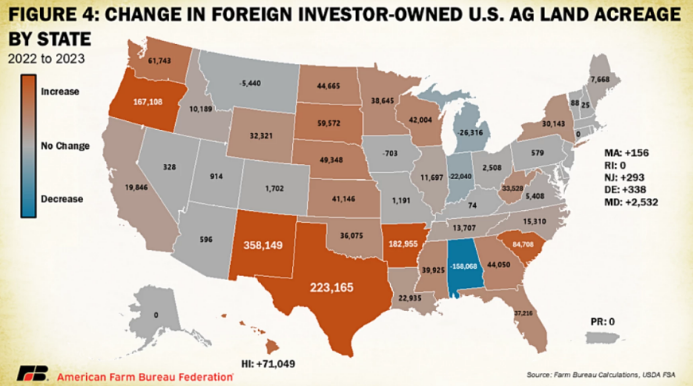By Ryan Hanrahan
The Federal Reserve Board on Wednesday released its April 2024 Beige Book update, a summary of commentary on current economic conditions by Federal Reserve District. While the report covers generalized “regional economic conditions and prospects,” it also includes the following observations pertaining to the U.S. agricultural economy.

Graph of Fed Districts from, “The Beige Book.”
Sixth District — Atlanta
“Agricultural conditions showed modest improvement in recent weeks. The cattle market saw continued resilience as limited supply kept prices high. Record inventories of milk depressed prices, but demand for dairy was strong and growing. Some increase in demand for poultry led to more optimism in the market, but many producers struggled as significant export restrictions remained in place. Florida growers reported high demand for citrus, but some softness in the row crop market.”
Seventh District — Chicago
“Prospects for 2024 farm income were little changed overall for crop and livestock producers with contacts continuing to expect incomes in 2024 to fall below 2023 levels. Field work in preparation for planting was well ahead of the usual pace given warmer-than-usual temperatures. Precipitation across the District improved water levels, though some areas remained in drought. Corn and soybean prices increased slightly amid expectations that farmers would plant fewer of these crops than earlier anticipated. Wheat prices were generally lower. Egg prices fell, most dairy prices were down, and hog prices were higher. Cattle prices rose despite a decline toward the end of the period after news of an avian flu outbreak in cattle raised concerns that beef demand would weaken.”
Eighth District — St. Louis
“Total acres planted as of the end of March are about the same as this time last year. However, contacts in Arkansas said they’re closely watching weather over the next few weeks; if conditions remain wet, that will limit future plantings and may force producers to plant later than is ideal. The distribution of crops is expected to shift: The number of acres of corn planted decreased, especially in Arkansas and Mississippi, while plantings of cotton, rice, and soy increased. For corn and cotton, this marks a return to 2022 acreage. Several District contacts reported feeling price pressures due to higher travel costs of bringing in H2A visa labor. Contacts also noted difficulties accessing farming equipment due to high costs and delays, particularly for repairs.”
Ninth District — Minneapolis
“District agricultural conditions were stable at low levels. Contacts expected decreased farm incomes in the region for the 2024 growing season. Warm weather along with widespread mild drought conditions led to a mixed outlook heading into spring planting.”
Tenth District — Kansas City
“Agricultural economic conditions in the Tenth District continued to moderate through the end of March. Agricultural bankers reported a mild deterioration in farm borrower liquidity and a gradual softening in farm loan repayment rates. Crop prices were subdued, and some contacts reported slightly higher instances of carryover debt than a year ago. Cattle prices remained strong, however, and provided ongoing support to the sector. Elevated production expenses and high financing costs remained ongoing concerns for all types of operations. Drought was also cited as an issue in some areas of the region. Farm real estate values increased at a slower pace compared to recent months, but valuations were strong despite the moderation in the farm economy.”
Eleventh District — Dallas
“Drought conditions remained prevalent in West Texas and southern New Mexico, while the rest of the District received ample rainfall over the reporting period. Texas experienced the largest wildfire in state history, burning over a million acres in the Texas Panhandle in late February and early March. Several thousand cattle were lost, and the fire destroyed infrastructure and pastures used for grazing. More cotton acres are expected this year as prices are relatively strong compared with corn and sorghum prices, which are at three-year lows. Contacts were optimistic about crop production prospects this year. On the livestock side, cattle prices pushed to record highs and beef demand has held up well.”
Twelfth District — San Francisco
“Retail and food service demand for agricultural products was flat to down. Transportation and packaging costs were stable to down, and growers noted that recent rainfall, while providing much-needed water for crops, caused flooding and damage. One contact in the Pacific Northwest noted that more growers have utilized temporary foreign worker programs to address domestic labor shortages in hiring for this year’s harvest season.”
Source : illinois.edu